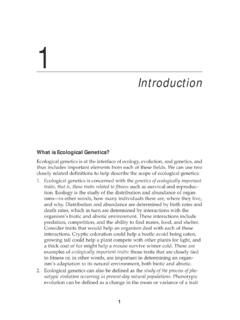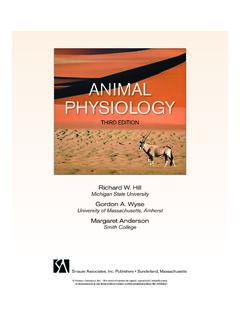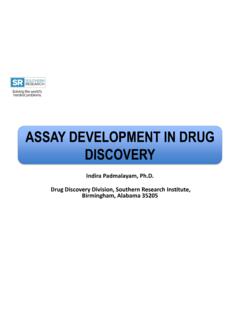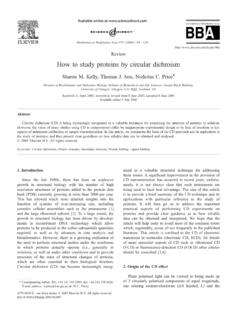Transcription of The Cell: A Molecular Approach, Sixth Edition
1 THE CELLA Molecular ApproachSixth EditionGeoffrey M. Cooper Robert E. HausmanBoston UniversitySinauer Associates, Inc. PublishersSunderland, Massachusetts 2013 Sinauer Associates, Inc. This material cannot be copied, reproduced, manufacturedor disseminated in anyform without express writtenpermission from ContentsPART IIntroduction 1 Chapter 1 An Overview of cells and Cell Research 3 Chapter 2 The Composition of cells 43 Chapter 3 Cell Metabolism 73 Chapter 4 Fundamentals of Molecular Biology 103 PART IIThe Flow of Genetic Information 151 Chapter 5 The Organization and Sequences of Cellular Genomes 153 Chapter 6 Replication, Maintenance.
2 And Rearrangements of Genomic DNA 191 Chapter 7 RNA Synthesis and Processing 239 Chapter 8 Protein Synthesis, Processing, and Regulation 297 PART IIICell structure and Function 343 Chapter 9 The Nucleus 345 Chapter 10 Protein Sorting and Transport 373 Chapter 11 Bioenergetics and Metabolism 421 Chapter 12 The Cytoskeleton and Cell Movement 459 Chapter 13 The Plasma Membrane 515 Chapter 14 Cell Walls, the Extracellular Matrix, and Cell Interactions 557 PART IVCell Regulation 587 Chapter 15 Cell Signaling 589 Chapter 16 The Cell Cycle 641 Chapter 17 Cell Death and Cell Renewal 681 Chapter 18 Cancer 713 2013 Sinauer Associates, Inc.
3 This material cannot be copied, reproduced, manufacturedor disseminated in anyform without express writtenpermission from xixOrganization and Features of The Cell xxiMedia and Supplements to Accompany The Cell xxiiiPart I Introduction 1 CHAPTER 1An Overview of cells and Cell Research 3 The Origin and Evolution of cells 4 The first cell 4 The evolution of metabolism 6 Present-day prokaryotes 8 Eukaryotic cells 9 The origin of eukaryotes 10 The development of multicellular organisms 13 cells as Experimental Models 17E. coli 17 Yeasts 18 Caenorhabditis elegans 18 Drosophila melanogaster 19 Arabidopsis thaliana 19 Vertebrates 20 Tools of Cell Biology 22 Light microscopy 22 Electron microscopy 28 Subcellular fractionation 31 Growth of animal cells in culture 32 Culture of plant cells 36 Viruses 36 KEY EXPERIMENTA nimal Cell Culture 34 Molecular MEDICINEV iruses and Cancer 37 Summary and Key Terms 39 Questions 40 References and Further Reading 41 CHAPTER 2 The Composition of cells 43 The Molecules of cells 43 Carbohydrates 44 Lipids 46
4 Nucleic acids 49 Proteins 52 Cell Membranes 58 Membrane lipids 58 Membrane proteins 59 Transport across cell membranes 62 Proteomics: Large-Scale Analysis of Cell Proteins 65 Identification of cell proteins 65 Global analysis of protein localization 67 Protein interactions 68 2013 Sinauer Associates, Inc. This material cannot be copied, reproduced, manufacturedor disseminated in anyform without express writtenpermission from ixKEY EXPERIMENTThe Folding of Polypeptide Chains 54 KEY EXPERIMENTThe structure of Cell Membranes 62 Summary and Key Terms 70 Questions 71 References and Further Reading 71 CHAPTER 3 Cell Metabolism 73 The Central Role of Enzymes as Biological Catalysts 73 The catalytic activity of enzymes 73 Mechanisms of enzymatic catalysis 74 Coenzymes 76 Regulation of enzyme activity 79 Metabolic Energy 81 Free energy and ATP 81 The generation of ATP from glucose 84
5 The derivation of energy from other organic molecules 89 Photosynthesis 90 The Biosynthesis of Cell Constituents 91 Carbohydrates 92 Lipids 93 Proteins 94 Nucleic acids 98 KEY EXPERIMENTA ntimetabolites and Chemotherapy 97 Molecular MEDICINEP henylketonuria 98 Summary and Key Terms 99 Questions 100 References and Further Reading 101 CHAPTER 4 Fundamentals of Molecular Biology 103 Heredity, Genes, and DNA 103 Genes and chromosomes 103 Genes and enzymes 105 Identification of DNA as the genetic material 107 The structure of DNA 108 Replication of DNA 109 Expression of Genetic Information 110 Colinearity of genes and proteins 111 The role of messenger RNA 112 The genetic code 113 RNA viruses and reverse transcription 115 Recombinant DNA 118 Restriction endonucleases 118 Generation of recombinant DNA molecules 120 Vectors for recombinant DNA 122 DNA sequencing 124 Expression of cloned genes 126 Detection of Nucleic Acids and
6 Proteins 127 Amplification of DNA by the polymerase chain reaction 127 Nucleic acid hybridization 129 Antibodies as probes for proteins 132 Gene Function in Eukaryotes 135 Genetic analysis in yeasts 135 Gene transfer in plants and animals 136 Mutagenesis of cloned DNAs 139 Introducing mutations into cellular genes 140 Interfering with cellular gene expression 142 KEY EXPERIMENTThe DNA Provirus Hypothesis 117 KEY EXPERIMENTRNA Interference 144 Summary and Key Terms 146 Questions 148 References and Further Reading 148 2013 Sinauer Associates, Inc.
7 This material cannot be copied, reproduced, manufacturedor disseminated in anyform without express writtenpermission from ContentsPart II The Flow of Genetic Information 151 CHAPTER 5 The Organization and Sequences of Cellular Genomes 153 The Complexity of Eukaryotic Genomes 153 Introns and exons 155 Repetitive DNA sequences 159 Gene duplication and pseudogenes 161 The Sequences of Complete Genomes 162 The genomes of bacteria and yeast 163 The genomes of Caenorhabditis elegans, Drosophila melanogaster, and other invertebrates 165 Plant genomes 166 The human genome 166 The genomes of other vertebrates 169 Chromosomes and Chromatin 171 Chromatin 172 Centromeres 176 Telomeres 180 Bioinformatics and Systems Biology 181 Systematic screens of gene function 181 Regulation of gene expression 182 Variation among individuals and genomic medicine 184 KEY EXPERIMENTThe Discovery of Introns 156 KEY EXPERIMENTThe Human Genome 167 Summary and Key Terms 186 Questions 187 References and Further Reading 188 CHAPTER 6 Replication, Maintenance.
8 And Rearrangements of Genomic DNA 191 DNA Replication 191 DNA polymerases 192 The replication fork 193 The fidelity of replication 200 Origins and the initiation of replication 201 Telomeres and telomerase: maintaining the ends of chromosomes 205 DNA Repair 207 Direct reversal of DNA damage 208 Excision repair 210 Base-excision repair 210 Nucleotide-excision repair 210 Transcription-coupled repair 213 Mismatch repair 213 Translesion DNA synthesis 216 Repair of double-strand breaks 216 DNA Rearrangements 219 Site-specific recombination 219 Transposition via DNA intermediates 227 Transposition via RNA intermediates 228 Gene amplification 232 Molecular MEDICINEC olon Cancer and DNA Repair 215 KEY EXPERIMENTR earrangement of
9 Immunoglobulin Genes 220 2013 Sinauer Associates, Inc. This material cannot be copied, reproduced, manufacturedor disseminated in anyform without express writtenpermission from xiSummary and Key Terms 233 Questions 235 References and Further Reading 236 CHAPTER 7 RNA Synthesis and Processing 239 Transcription in Prokaryotes 239 RNA polymerase and transcription 240 Repressors and negative control of transcription 243 Positive control of transcription 245 Eukaryotic RNA Polymerases and General Transcription Factors 245 Eukaryotic RNA polymerases 246 General transcription factors and initiation of transcription by RNA polymerase II 246
10 Transcription by RNA polymerases I and III 250 Regulation of Transcription in Eukaryotes 251cis-acting regulatory sequences: promoters and enhancers 251 Transcription factor binding sites 255 Transcriptional regulatory proteins 258 structure and function of transcriptional activators 260 Eukaryotic repressors 263 Regulation of elongation 264 relationship of chromatin structure to transcription 266 Regulation of transcription by noncoding RNAs 271 DNA methylation 273 RNA Processing and Turnover 275 Processing of ribosomal and transfer RNAs 275 Processing of mRNA in eukaryotes 277 Splicing mechanisms 279 Alternative splicing 286 RNA editing 288 RNA

















